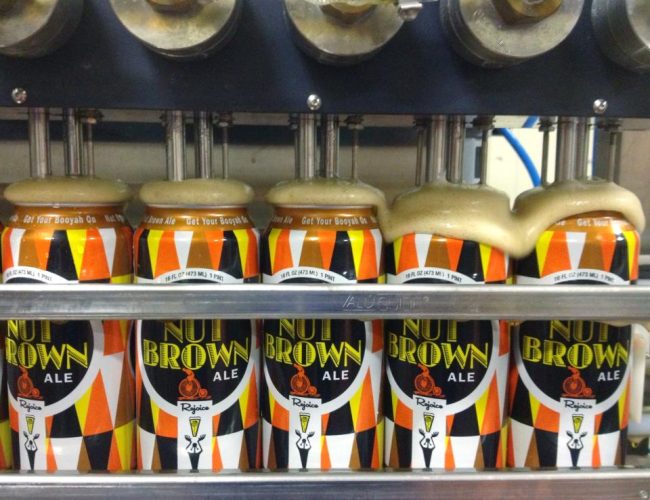As if anyone needed another reason to visit the stunning red rock country of southern Utah, Moab Brewery’s bustling taproom and restaurant offer craft beer lovers a fitting sanctuary after a day of adventure in the surreal looking surroundings.
A geologist’s and hiker’s fantasy world, Moab is widely regarded as one of the premier mountain-biking destinations in North America. So, it’s easy to understand why Moab Brewery’s beers sport such names as Derailleur Ale and Rocket Bike Lager, and why the brewery’s typically jam-packed parking lot is filled with cars whose license plates from every state in the country are covered with red dirt.
“We have an audience of 7,000 people here, but I’m speaking to audiences that are much larger,” says head brewer Jeff Van Horn. “So, in town we do have a great following with locals and what-not, but we don’t have the mass. You may have 100 people here that love you to death, but with us, we’re speaking to the world.”
Breweries, like anything else, can often fall short of expectations in tourist-heavy towns. Crowds are a given regardless of quality, and so quality sometimes takes a back seat to the bottom line. Van Horn, however, who began homebrewing way back in 1988 and took over at Moab Brewery 14 years later, is serious about his craft, and was rewarded in a big way with medals at both the 2014 World Beer Cup® and Great American Beer Festival® (GABF).
If that weren’t enough honors for a single year, Sierra Nevada Brewing Co. owner Ken Grossman and his Beer Camp Across America touring companions valued a stop at Moab Brewery enough to veer their tour bus off Interstate-70 en route from San Diego to Denver this summer—delivering a nice little surprise for Van Horn and his crew.
Expansion and Out-of-State Distribution
Moab Brewery opened its doors in 1996, starting with a 15-barrel AAA Metal Fabrication brewing system that still is in operation. In 2002, when Van Horn came aboard, the company expanded on site by purchasing fellow Utah brewer Park City Brewing Co. and its larger equipment. Moab retained a couple of Park City recipes, including Rocket Bike Lager, an American-style steam beer that still flows in the taproom and earned a bronze medal at the 2014 GABF.
In 2014, Van Horn expects to crank out close to 10,000 barrels of beer, roughly 1,200 barrels of which will be consumed in the tasting room/restaurant and three other accounts in town. The rest is for packaging.
About three years ago Moab Brewery built an extension off the back of the brewery that now houses several bright beer tanks and a canning line, enabling the company to expand distribution across the U.S.

The beers now are available in select markets across nine states, from northern California in the West to Washington D.C. and surrounding states in the East, with full coverage in neighboring Colorado.
“The response has been great out of state, which is shocking for me,” Van Horn says. “I mean, who wants Utah beer? I really wasn’t sure how that was going to go over. In Colorado you’ve got hundreds of breweries—what would you want a Utah beer for? But people like quality beer, and I think that’s what we try to rest our hat on.”
One of the major hurdles for Moab and all Utah breweries is the “three-two” dilemma—the state’s 4.0 percent alcohol by volume, or 3.2 percent by weight, cap on draft beer and bottled/canned beer sold in grocery and convenience stores.
While many consumers mistakenly assume all Utah brews are “three-two beer,” higher strength versions are allowed for sale in state liquor stores. And, as a manufacturer, Moab Brewery possesses a license to sell bottles of its high-gravity beers both at retail in the brewery gift shop as well as to patrons in the taproom/restaurant.
They include the Desert Select Ale series that highlight Van Horn’s bottle conditioning program. The five beers—Black Imperial IPA, Belgian-style Triple, Scotch Ale, Export Stout and Hopped Rye—are all hand-bottled using a wine filler, and each 22-ounce bomber undergoes three weeks of warm storage to facilitate the refermentation in the bottle.
Moab Brewery produces another dozen beers for on- and off-premise sales, all of which have a 4.0 percent ABV (or “three-two”) version created by Van Horn and his 10-man crew.
“We have 17 products, so it makes it hard to juggle…but that’s the corner we’ve painted ourselves into,” the head brewer concedes. “We like having 17 brands, but it doesn’t make our life any easier.”
Van Horn says that brewing two versions of each beer to meet state distribution requirements has “only made us better brewers,” furthering Van Horn’s already strict attention to detail.
His biggest goal is consistency from batch to batch, whether it’s the top-selling Johnny’s IPA or Dead Horse Amber Ale—named after the jaw-dropping overlook and state park just outside Moab that was featured in the 1991 Hollywood film, Thelma and Louise.
The brewery’s beers don’t prominently feature the word Moab on the label—a different marketing strategy that Van Horn says created a lot of bantering within the company. Instead of the Moab hook, consumers are encouraged to give the label a read, and Van Horn hopes the competitive price point and quality get beer in people’s hands “and hopefully they won’t put it down.”
“If you see it in a package,” he says, “it was probably four years of me messing around with it on the homebrew side. I’m not going to just shoot from the hip and release it.”
CraftBeer.com is fully dedicated to small and independent U.S. breweries. We are published by the Brewers Association, the not-for-profit trade group dedicated to promoting and protecting America’s small and independent craft brewers. Stories and opinions shared on CraftBeer.com do not imply endorsement by or positions taken by the Brewers Association or its members.


Share Post